The design for the M1 Garand underwent a whole slew of changes large and small before finally reaching the form ultimately adopted by the US military. Well, the clips that it fed from were no different – they also underwent a design evolution. We would expect a need to refine the clip design for good reliable performance, but changes to the rifle required a couple major redesigns of the clips as well. Initially, of course, the Garand rifle was built to hold 10 rounds of .30-06 ammo, which then changed to 10 rounds of .276 Pedersen before the final revision back to 8 rounds of .30-06.
Well, I came across these scans of Ordnance Department photos of the various iterations. I apologize for the somewhat marginal quality of the scans, but they still give a pretty good idea of the changes that were made. As best I can tell, these were taken in 1931, and they do not include the final design (note that the final variant shown still has a corrugated bottom surface, instead of the circle and curved grooves that were ultimately used).
Top views:
Clearly the first two versions would have put too much pressure on the rounds to allow reliable feeding. The later designs show the pattern of removing material to save weight and strengthening parts of the clip to improve durability. When looking at these, it’s important to remember that John Garand was designing the manufacturing tooling to make his rifle in addition to the rifle itself. I expect he was carefully trying to balance the requirements of durability, weight, cost and reliability in addition to making a clip design as efficient as possible to manufacture, with a minimum number of stamping operations and best repeatability for QC.

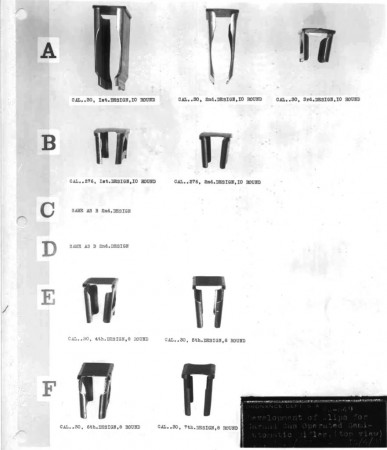
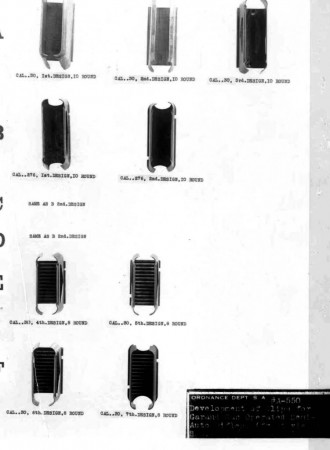
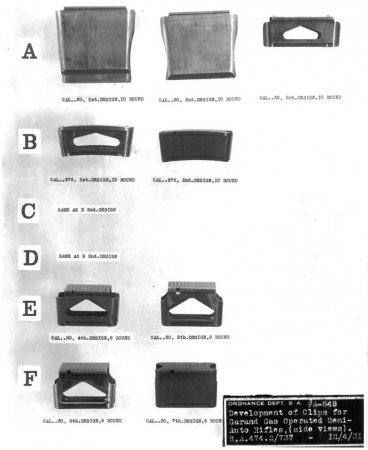

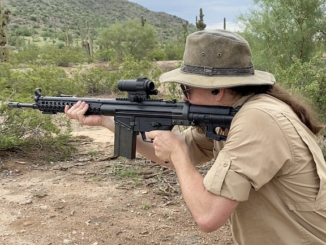
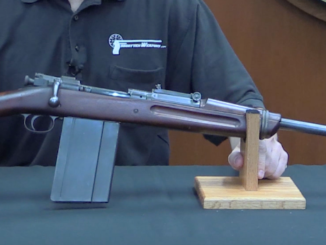
As a Garand collector I’m always pleased and amazed at the information that continues to pop up. Thanks Ian!!
A lot of work when a Box mag would have worked a lot better and could have used the BAR mag…
I know a lot of people love these clips but I am not one of them…
I wouldn’t say I “love” them – a box mag is much easier by far. “Quaint” might be a better word. 😉 The endbloc answered two (biased) concerns of the Army – it kept loading similar to what troops already knew – 5 round stripper clips into 1903’s or 1917’s. After WW1 box mags were still new and Army brass were suspicious of them. Why? ‘Cause they were new. Remember the search for the semi-auto began in the late teens. Garand’s rifle wasn’t fully adopted till circa 1937. There was an effort to “disarm”, reduce military spending – all influences on the design process. During WW2 the Army discovered the limitations of the 8 round enbloc and moved towards development of a box mag rilfe (M14) coming up with the M1 Carbine just prior to our entry into hostilities.
Two points I missed including above. The Army had every confidence in the BAR but some were worried about EVERY soldier being able to “spray & pray” – wasting ammo in their minds. Also the cost difference between a BAR & 1903 was a factor. The target price for a the new semi-auto was somewhere around $25- $30 each. I’m not sure if SA ever reached that goal.
Regarding the hesitancy to go to a box magazine, the army had box magazines not only for the BAR but also for the 1911, the Thompson SMG, and for the ill-fated Pederson Device.
I would speculate that the reason to avoid a box magazine that protruded from the bottom of the gun was to avoid exposure of troops firing out of fox holes or over other cover–get them closer to the ground. For a generation trained on firing the Springfield prone, they probably had no use for a big box magazine that would get in the way. That, and 12 more rounds and more sheet metal would have added weight. Not saying those were good reasons, but they probably occured to some one on the ordinance board.
Great information for the Garand aficionado! I really like mine! An unstated and overlooked rationale for NOT using a detachable box magazine is the risk of negligent discharges by “non-soldier proofed” soldiers… To unload the magazine, the entire action is opened, which unloads the chamber FIRST, and then the latch depressed to release the en-bloc clip. With the Pedersen device, BAR, and M-1 carbine “light rifle project” the magazine can be removed but a round could still be in the chamber. Note the latch on the M-1 carbine’s op-rod that allows for the bolt to be opened AND locked in the rearward position while the box magazine is removed…
The Soviets adopted the box magazine for the Tokarev self-loader, but only gave some three magazines or so with the rifle. Their rifle designers decided that these spare magazines were excessive weight, required more resources, and were prone to being lost. If the box magazine was removed and lost, the rifle was now a singl-shot. So the SKS self-loading carbine had a fixed ten-round magazine and used top-loading chargers to replenish the magazine. Not the manual of arms of the SKS: dump the cartridges into the hand, then pull back the bolt to clear the chamber, or vice-versa if “mis-handled.”
In the 1930s detachable box magazines seemed to imply specialized training, e.g. SMGs, LMGs, pistols, Automatic rifles, etc.
Very good point and it is indicative of process the rifle’s acceptance have gone thru. What was deemed too risky 50 years ago is commonplace now. Order of clearing starting with magazine, following to chamber is a standard and nobody seem to have problem with it.
David, the Russians were familiar with the en bloc clip. Simonov used it for the 14.5mm PTRS anti-tank rifle, which otherwise closely resembles an SKS-45 with a thyroid problem. The magazine of the PTRS is very like the SKS: similar follower, similar mag-dump catch, except that’s also where the en bloc clip went in.
Tokarev rifle was sometimes issued with no spare magazine, like the Lee-Enfield, which technically had a detachable magazine that just didn’t get detached in routine operation.
The SVT-38 and -40 were loaded conventionally with Mosin-Nagant strippers. The stripper clip guide is part of the bolt carrier, like the Simonov AVS-36 and SKS-45.
In the years leading up to World War II, most militaries did not see a need for more firepower from the rifleman. The idea was the riflemen delivered aimed fire at point targets, area targets were engaged by MGs, mortars, and supporting arms.
By the way, someone mentioned the Johnson. The same receiver was used in the rotary-mag, stripper-loaded rifle, and the box-mag LMG. The barrel differed only in that the LMG had a raised sight line and therefore a prominent front sight base.
Why the change from 10 round mags to 8 round mags on the Garand? Was there some issue with feeding from the 10 round enbloc clip when compared with the later 8 round.
It had been reworked for 10 of the .276 rounds, then switched back to the 30-06 at the last minute. My guess is that 8 30-06 rounds fit in the same space that 10 .276 rounds fit in, maybe a Garand historian can shed more light on it.
On the subject of detachable box magazines, the Johnson rifle didn’t have one either did it?
Jacob is correct but weight limitations imposed by the Army were also a consideration. And consider that Garand and others (Pedersen, Johnson) were asked to “up size” their .276 Cal designs after the Army Chief of Staff (Douglas McArthur) decided there was too much .30-06 laying around after WW1 not to use it in the “new” semi-auto rifle. If you compare a modern .270 round with a .30-06 you see the dilemma – just increasing the receiver portion of a rifle to accept 10 rounds of a larger caliber doesn’t make it an equal performing firearm. And it came back to weight. I believe 8 rounds of .30-06 weigh about the same as 10 rounds of .276 but someone check that for me.
Originaly the Garand had a 20 round detatcheble box magasine.
It was considerd to expensive in amo, so Mc Artur sugested a clip as for the french Bertier of witch he was familar from 1. WW, so the clip is french, the gas system is danish(Bang 1921), the turnbolt closure is danish(Qist 1899) John C Garand may be american, bur the ideas, are eurropean.
Actually, Garand was Canadian. I believe he was at the Bureau of Standards, not Springfield Armory, much less the War Dept, when he began work on his rifle.
Hi,
Have look on this page (it’s in french), you’ll can see some similarities.
http://armesfrancaises.free.fr/FSA%201917.html
This is more speculation, but the Army may have wanted to maximize the total ammo carried by each GI. Obviously more could be carried in clips versus magazines. The contention may have been that in combat some troops would reload while others were still shooting. The intensity of continuous firing might not be much if any less, and by carrying more ammo that volume of fire would last longer.
Thinking as an individualist, give me the biggest box magazine there is. Thinking as a leader of a unit, light clips that maximize ammo carried aren’t that bad of an idea. Not an issue today with light rounds and light magazines.
There are also accounts of GI’s who were issued M1 carbines who discarded them for picked up Garands. They preferred 8 heavy hitting rounds to 15 light rounds in a box magazine. They were more concerned about a crazed Jap continuing at them after being hit than they were about running dry.
Jacob:
I’ve read similar things about the Carbine being discarded – primarily in the Pacific. My knowledge of the M1 Carbine isn’t the best but I recall reading the Carbine was intended to be a “behind the lines” weapon….something with more rounds and greater range than the .45, less weight/smaller than the Garand and cheaper than the Thompson. Primarily intended for 2nd echelon troops. But in the Pacific the definition of a “line” was much more like Vietnam than it was in Europe. My father had many stories about Japs popping unexpectedly when they least expected it.
Actually, the fact that Garand was originally tool designer a continued with that activity on his own creation may have helped a lot. In common industrial practise there is clear divide between the two with a fair dose of bickering involved. Everyone defends their own turf.
John Cantius Garand was a Qúebecois French Canadian. Ian has helpfully posted some archival footage of him speaking with a thick Quebec French accent!
Garand’s first rifle design used the primer moving back during full recoil to actuate the mechanism. He designed the Garand rifle and the production machinery and tooling to produce it.
The 10-shot .276 Pedersen caliber rifle was lighter and handier, like 9 lbs. instead of the .30-06’s 11. It might have obviated the need for the carbine/”light rifle” project.
The M-1 carbine was developed out of a concern that German tactics displayed at the start of WWII [e.g. the vaunted “Blitzkrieg”] made the old WWI-era conception of a “front line” somewhat moot. Truck drivers, cooks, mortarmen, artillerists, jeep drivers, members of crew-served weapons, etc. etc. would be swept up in combat and pistol marksmanship simply didn’t cut it. At one point the idea was to replace the 1911A1 pistol and all the .45 acp SMGs in inventory with carbines, but instead all of these small arms were churned out in record numbers as were the carbines. There were cases in North Africa already where U.S. officers discarded carbines for Garand rifles due to the fact that the carbine was a great substitute for a handgun, but not a real substitute for a rifle. Similar concerns motivated soldiers so equipped in the European and Pacific Theaters. The first concerns about “stopping power” I am aware of emanated during the Battle of the Bulge, but these claims became more numerous during the fighting in Korea against the KPA and the Chi-Com PLA “volunteers” in thick, padded garments.
Ian’s Japanese type 4 video led me to this article based on his comment regarding clip design problems Garand’s gas operated rifle that was to become the M1 30 Cal Rifle. When I saw that 10 round clip I was confused as I do not remember a 10 round 30 Cal Garand gas operated rifle. I found the corresponding images with matching clip letters in Hatchers Book of the Garand pg.112. “1931 photo showing evolution of the gas-operated Garand semiautomatic. (A)the first model was never completed. It was to use a single row, Mannlicher type clip.”
I think that Pedersen may have sold the army on the enbloc clip. Coincidentally, the BAR didn’t have a very good magazine: flimsy and expensive. The M1 clip cost less than one round of ball ammunition.
The BAR magazine would not push rounds up fast enough for the faster cycling Garand. It would have required a new magazine, and that would have raised an additional objection to the adoption of the rifle.
IMO, there’s no way Mr Garand didn’t know about Stripper Clips; meaning he intentionally avoided their use in the M1.
His goal I think, was to make reloading as fast as possible i.e, while a stripper clip Garand would be narrower/lighter/cheaper(?); an Enbloc M1 is faster to reload with 8 rounds (2 stacks of 4).
Along these same lines, see the Article below; describing the Japanese copy of the M1.
While the actual US M1 Rifles apparently worked fine rebarrled to 7.7mm; the 30.06 Enblocs did not. So the guns were redesigned with a shallow Magazine; allowing the Rifle to hold two Arisaka 5-round Stripper Clips.
IIRC, this is how British SMLEs were loaded; allowing the Soldier to enter Battle with 10 rounds of ammo, and then reloading with 5 in Battle.
https://www.thearmorylife.com/a-japanese-garand/